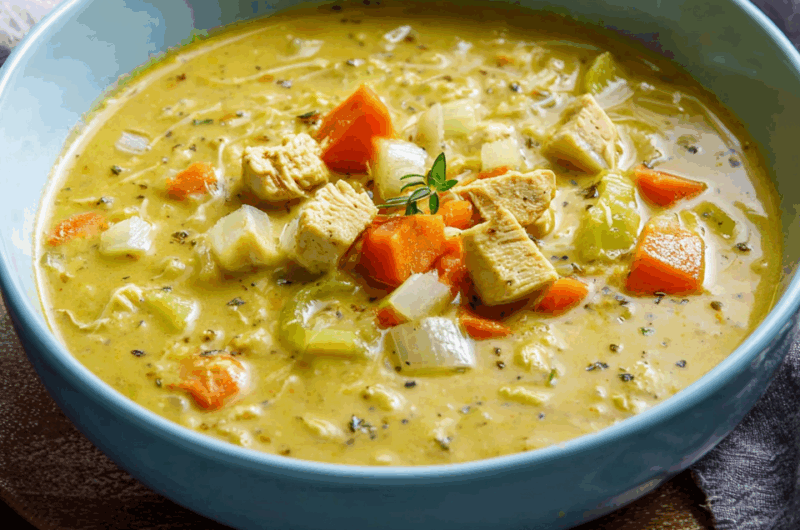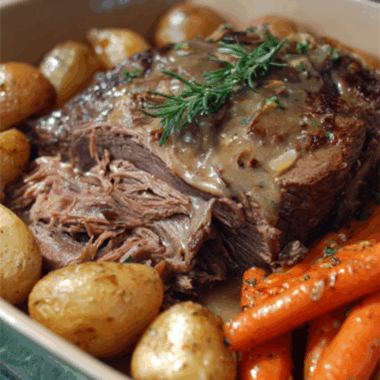The Mulligatawny Soup is a unique cross-cultural dish that brings together the best of British and Indian culinary traditions. This version is a hearty, creamy soup packed with chicken, rice, aromatic curry, and the unexpected but delightful sweetness of apple. Finished with a swirl of cream, it’s pure comfort in a bowl.
Its complexity lies in its simplicity — easy to prepare, yet layered with flavor and warmth. The richness of butter, subtle heat from curry powder, and the freshness of herbs come together beautifully, making this soup a staple for cold nights or when you crave something a little exotic but very familiar. Mulligatawny is perfect for family meals, cozy dinners, or your next soup-and-sandwich lunch combo.
Full Recipe:
-
4 tablespoons butter
-
1 large onion, chopped
-
2 celery stalks, chopped
-
1 carrot, chopped
-
1/4 cup all-purpose flour
-
1 1/2 teaspoons curry powder
-
6 cups chicken broth
-
1 apple, peeled, cored, and chopped
-
1/4 cup white rice
-
1 cup cooked, diced chicken breast
-
1/2 teaspoon dried thyme
-
Salt and pepper to taste
-
1/2 cup heavy cream, warmed
Directions:
-
Melt the butter in a large soup pot over medium heat.
-
Add chopped onion, celery, and carrot. Sauté for 5–7 minutes or until soft.
-
Stir in the flour and curry powder; cook while stirring for 5 minutes.
-
Gradually add the chicken broth, mixing well to avoid lumps. Bring to a boil, then reduce heat and simmer for 30 minutes.
-
Add chopped apple, rice, cooked chicken, thyme, salt, and pepper. Simmer for 15–20 minutes or until rice is tender.
-
Just before serving, stir in warmed cream.
-
Serve hot and enjoy a comforting, spiced soup!
Prep Time: 10 minutes | Cooking Time: 55 minutes | Total Time: 1 hour 5 minutes
Kcal: 275 kcal | Servings: 6 servings
The Rich Heritage of Mulligatawny Soup
Mulligatawny Soup is not just a comforting meal—it’s a culinary story, one that bridges colonial history with modern kitchen innovation. The word “mulligatawny” comes from the Tamil words milagu (pepper) and tanni (water), literally meaning “pepper water.” Its origin can be traced to South India, where British colonizers developed a taste for the spicy, soupy dishes made by local cooks and requested versions that suited their own palate.
The original South Indian dish was more of a peppery broth served with rice, often vegetarian and boldly seasoned. Over time, British interpretations of the soup incorporated meat (most commonly chicken or lamb), thickened the texture with flour or rice, and softened the spice level, introducing cream, apples, and carrots to create a dish more aligned with European preferences. The result is the Anglo-Indian hybrid we know today: a warming, slightly sweet, subtly spicy, and nourishing bowl of Mulligatawny.
A Soup with Layers of Global Influence
What makes Mulligatawny truly fascinating is its ability to morph across cultures. While its roots are Indian, the version most commonly consumed today is very much a British colonial creation. Over time, it’s traveled beyond the British Empire, landing in kitchens around the world—from New York delis to Canadian households—where it’s continued to evolve.
Modern versions of Mulligatawny often fuse various global elements. Some cooks add coconut milk instead of dairy cream, evoking the flavors of Thai cuisine. Others replace chicken with lentils or tofu for a vegetarian or vegan option. This ability to be adapted to different tastes and dietary needs is one of the soup’s greatest strengths and a key reason for its enduring popularity.
Flavor Profile: A Symphony of Sweet, Savory, and Spiced
The taste of Mulligatawny Soup is difficult to describe in a single word. It’s a medley of mild curry spice balanced by the sweetness of apples and carrots, enhanced by the umami depth of chicken broth and the creaminess of dairy or coconut milk. The rice adds a soft, chewy texture, while celery and onions bring in a vegetal backbone.
Curry powder—a blend of spices including turmeric, cumin, coriander, and fenugreek—plays a central role in flavoring the soup. But it’s not overwhelmingly spicy; rather, it’s fragrant and inviting. A good Mulligatawny warms the soul without burning the tongue, making it accessible even to spice-sensitive palates.
The Role of Apples: A Signature Twist
One of the most unique features of Mulligatawny Soup is the inclusion of chopped apples. While it may seem unconventional to add fruit to a savory soup, apples bring a subtle sweetness and a hint of acidity that balance out the richer, earthier flavors of the curry and broth. Green apples are often favored for their tartness, but any firm, sweet-tart variety can work.
Apples also soften slightly during cooking, but they still retain just enough texture to offer an interesting contrast to the tender chicken and rice. It’s this kind of unexpected ingredient that makes Mulligatawny stand out from more conventional soups.
Texture and Consistency: Between Soup and Stew
Mulligatawny straddles the line between soup and stew. Depending on how much rice you use and whether you choose to puree part of the broth, it can be either a rich, velvety liquid or a chunky, hearty bowl full of ingredients. This makes it ideal for customization based on your preference—add more broth for a lighter version, or let it simmer until thickened for a stew-like meal.
The cream, added at the end of the cooking process, gives the soup a luxurious finish. Some cooks use half-and-half, while others opt for full heavy cream or coconut cream. Each choice slightly alters the consistency and richness but maintains the soup’s characteristic smoothness.
Nutritional Benefits of Mulligatawny Soup
While Mulligatawny Soup is undeniably a comfort food, it also offers a range of nutritional benefits, especially when made with wholesome ingredients. Chicken provides a lean source of protein, essential for muscle repair and immune support. Carrots, celery, and onions contribute fiber, vitamins, and antioxidants.
The inclusion of apples adds natural sugars and additional vitamins like Vitamin C, which supports skin health and immune function. Rice offers carbohydrates for energy, and if you choose to use brown rice, you’ll also benefit from added fiber and magnesium.
Depending on whether you use cream or coconut milk, the soup can range from light to rich in healthy fats. Either way, it can be part of a balanced meal, particularly when paired with a side salad or crusty whole-grain bread.
Serving Suggestions: Versatile and Crowd-Pleasing
Mulligatawny Soup is highly versatile and can be served as a main course or a starter. For a light lunch, pair it with naan or pita bread and a dollop of plain yogurt or raita. As a dinner entrée, it goes well with a side of roasted vegetables or a fresh cucumber salad with mint and lemon.
It’s also excellent for meal prepping. The flavors deepen and meld over time, making it even better the next day. Store it in the fridge for up to 4 days or freeze it in individual portions for a quick, ready-made comfort meal whenever you need it.
For a more indulgent experience, drizzle a swirl of coconut milk or cream over the top just before serving, and sprinkle with chopped fresh cilantro or chives. A squeeze of lemon juice can also brighten the dish, enhancing the spices and adding a touch of acidity.
Mulligatawny Variations to Try
There are countless ways to reinterpret Mulligatawny while staying true to its flavorful foundation. Here are a few ideas for putting your own spin on this classic soup:
-
Vegetarian/Vegan Version: Skip the chicken and use vegetable broth. Add chickpeas, lentils, or diced tofu for protein.
-
Spicy Kick: Add fresh ginger, diced green chili, or a pinch of cayenne pepper for extra heat.
-
Coconut-Based: Replace the cream with full-fat coconut milk for a dairy-free, tropical flair.
-
Low-Carb: Swap the rice for cauliflower rice or omit it altogether for a lighter soup.
-
Middle Eastern Twist: Add cinnamon, allspice, or cardamom to the curry base and finish with toasted almonds or pine nuts.
These adaptations not only cater to different dietary preferences but also highlight the soup’s culinary flexibility.
The Comfort and Culture Behind the Bowl
What makes Mulligatawny Soup more than just a meal is its emotional and cultural resonance. It’s the kind of dish that brings people together—familiar and exotic, simple yet layered, nostalgic and exciting. It carries the imprint of its South Indian roots while being shaped by the tastes of generations of cooks from around the world.
It evokes the coziness of cold nights, the warmth of kitchens filled with rich aromas, and the joy of trying something just a bit out of the ordinary. For many, Mulligatawny is that go-to soup when they crave something hearty yet distinctive, a dish that stands apart from the usual chicken noodle or vegetable stew.
Conclusion: Why Mulligatawny Soup Belongs on Your Table
Mulligatawny Soup is far more than just a spicy soup with rice—it’s a testament to the power of culinary fusion and adaptation. It brings history into your kitchen, infuses traditional ingredients with modern twists, and satisfies on both a physical and emotional level.
Whether you’re a food blogger looking to showcase something unique, a home cook wanting to expand your repertoire, or simply a lover of warm, satisfying meals, this soup has something to offer. It’s comforting, customizable, and packed with character.








